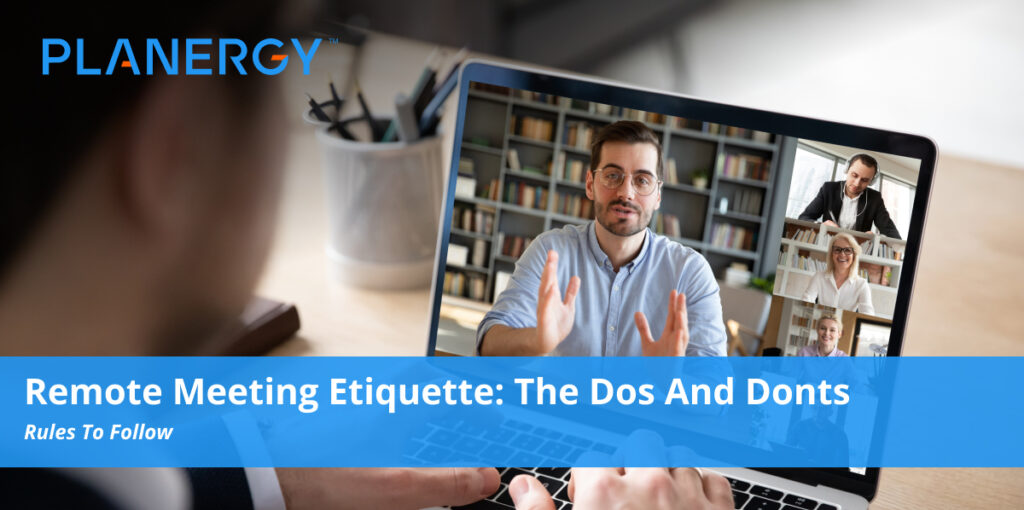While the COVID-19 pandemic forced many businesses to change the way they operate, for many companies, remote meetings were the norm.
As more organizations start to see the benefits of video conferencing – increased productivity and collaboration – many are learning that they may not have to return to the “old” face-to-face approach after all.
It is a cost-effective way to host team meetings with remote workers – whether you’re all local to one another or across the world.
However, to reap the most benefit, it’s crucial all attendees follow the appropriate virtual meeting etiquette. This is especially important for people who are new to the world of remote meetings.
Use these meeting etiquette tips to keep things running smoothly.
Test Technology Before the Meeting
Make sure you have the appropriate software installed on your computer before the meeting begins. Test your microphone and camera ahead of time.
If you run into any technical issues, reach out to someone for assistance before the start of the meeting,
This way, you don’t miss the meeting itself and can let your boss know what’s going on, should you not be able to attend the meeting live.
If you’re unsure of any of the technology, ask for help. Knowing how to use all the features is important to the success of the meeting.
It’s best to test it at least a few minutes ahead of the meeting time so that you’re not scrambling to make things work at the last possible second.
There are multiple meeting tools out there, and your company may test a few before deciding which one to use on a regular basis.
Dress Appropriately
It may be tempting to dress only from the waist up or wear your pajamas, but you never know when you may have to adjust or get up.
This means you run the risk of your fellow coworkers seeing you without pants on if you have the camera tilted down too far or need to get up for a moment.
While pajamas may be comfortable, they aren’t conducive to productivity, and they certainly don’t look professional.
There’s nothing that says you have to dress up, but at least make sure you’re fully dressed, and that your hair is presentable.
Women who enjoy wearing makeup may wish to put it on, but if you don’t feel like it, or are too busy working on other things, it’s okay to skip it.
Regardless of what you do, the key is to look like you care about your appearance, not that you’ve been a shut-in for weeks….even if you can’t remember the last time you left your home.
Consider Your Background
Think about where you will be during the meeting. Many people don’t have a dedicated workspace for working from home. If you have to work from the dining room, consider what could show in the background when your camera is on.
What can be seen in the background can be a distraction for you and for other attendees.
That’s why it’s a good idea to test lighting and other factors to make sure you are easily visible.
If you want to hide a mess or make it easier to appear professional, you can hang a blanket behind you, or use a professional backdrop.
Some platforms, like Zoom, make it possible for attendees to use a green screen-like background to hide what’s really behind them.
A general rule of thumb is to behave just as if you were in the office with your coworkers.
Attend in a Quiet Area if Possible
Though can mute yourself when you’re not speaking (more on that in a second), it’s better for everyone if you can attend from a quiet place.
This may mean going to a bedroom and closing the door, to keep children and pets away. It may mean closing the windows to drown out sounds of traffic if you live near a busy highway.
The background noise that comes through when you speak can make it harder to hear you and distract attendees.
Remain Muted While Others Speak
Unless you are a facilitator who must remain unmuted for the duration of the conference, mute yourself when you’re not the one speaking,
When everyone does this, it makes it easier for the speaker to be heard, and for the rest of the group to focus.
Some meeting platforms give the organizer the option to automatically mute everyone, so you may need to ask to be unmuted when you need to speak.
If you were sitting in a business meeting in a conference room, you wouldn’t speak out of turn or interrupt someone. Muting your microphone helps prevent unnecessary interruptions.
Look at the Camera
Even if you’re not the one speaking, it may still be possible for others to see your camera feed. It depends on the meeting platform your company uses, so this is another reason why it is a good idea to test your setup before the meeting starts.
Looking directly into the camera and maintaining eye contact at all times indicates that you are giving your full attention and helps you remain alert in the meeting.
It’s always best to assume your camera feed is visible to all the other attendees, to avoid them seeing something you don’t intend for them to see. When you speak, do so clearly and at a reasonable volume. You want to make it easy for other attendees to hear you without needing to adjust their speakers.
Beyond looking into the camera, you should also consider your body language. If you’re slouched in your chair, this indicates that you’re bored or not really listening to the speaker.
Your team members can pick up on this, and it can derail the meeting.
Don’t Go “Mobile”
If you need to visit the restroom while you’re in the meeting, don’t take your computer or your phone with you.
Even if you turn off your camera, it’s not a good idea. You may forget to mute yourself – or get into the habit of taking a trip across your home, only to realize this time you’ve forgotten to turn off the camera and mute yourself.
Now, everyone knows you weren’t wearing pants and can hear what should remain private moments for a reason.
While it’s best to go to the bathroom before the meeting starts, if you find that you need to go during the meeting or have another distraction that needs your attention, you should excuse yourself just like you would in person.
Use Audio-Only in a Pinch
While being on camera may not be your idea of fun, it’s best for everyone if you are. It really helps to create a feeling of connection and simulate the idea that you’re all in the same room together.
That said, there are some situations where being on video just isn’t ideal – like when you need to attend a meeting while your children are at sports practice, or when your computer just doesn’t want to cooperate.
Ideally, your meeting platform will have an option where you can dial into the meeting with your phone, so you don’t have to rely on your computer speakers and a headset microphone.
If you cannot connect to the meeting with video, this is the next best thing.
Just remember to announce who you are before you speak since people won’t have a face to match you to and may not recognize you by voice. If you’re working as part of a remote team and have never met face-to-face, this is especially important.
If possible, set up your profile to include a thumbnail image of your headshot, so that if your profile shows up on the main screen while you’re speaking, people will at least have a face to match the voice and name.
Avoid Multitasking
With an online meeting, it’s tempting to turn off your webcam and mute your audio so you can keep doing things while listening to the video conference.
Since no one can see you like they can with an in-person meeting, you may even be tempted to do other remote work or watch TV or play games while on the conference call.
This also means avoiding side conversations with others in chat rooms or on social media. Treat all video calls as if you were sitting face-to-face with all the other meeting attendees.
Even if you know the meeting will be recorded so you can watch it later, you should always operate under the assumption that the information presented will not be repeated or shared again.
Expect that the facilitator will check in with you to follow up on anything you were assigned, or to make sure you don’t have any questions or concerns bout what was covered. Multi-tasking will make it harder for you to keep track of everything you need to pay attention to.
Protect Sensitive Information
If you will be sharing your screen at any point during the video chat, make sure you have closed any files that contain sensitive information. Share only what the others need to have access to.
Remote working comes with its set of challenges, but with these video conferencing etiquette rules, you are one step ahead for your next meeting.




